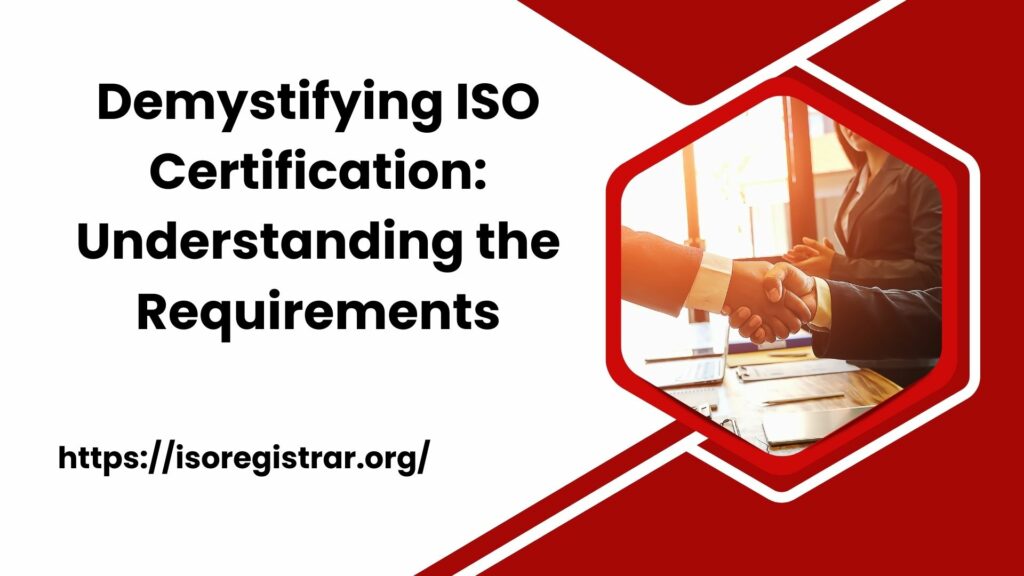Introduction:
In today’s globalized business landscape, organizations strive to establish their credibility, reliability, and commitment to quality. One of the most recognized international standards for achieving this is the ISO certification. The International Organization for Standardization (ISO) develops and publishes a range of standards that provide guidelines and requirements for various aspects of business operations. Attaining ISO certification can enhance an organization’s reputation, increase customer confidence, and open doors to new opportunities. In this article, we will delve into the requirements for obtaining ISO certification and shed light on the process involved.
Choosing the Appropriate ISO Standard:
The first step towards ISO certification is identifying the most relevant ISO standard for your organization. ISO offers certifications in various areas, including quality management (ISO 9001), environmental management (ISO 14001), information security (ISO 27001), and many more. Selecting the appropriate standard depends on your industry, business objectives, and customer requirements.
Understanding the Standard’s Requirements:
Once you have determined the ISO standard that aligns with your organization’s needs, it is essential to comprehend the specific requirements outlined in the standard. These requirements serve as a framework for establishing effective management systems and processes within your organization. They typically cover areas such as documentation, procedures, resources, risk management, and continuous improvement.
Conducting a Gap Analysis:
Before initiating the certification process, it is crucial to assess your organization’s existing practices and systems against the requirements of the chosen ISO standard. This gap analysis helps identify areas where your organization already meets the standard’s criteria and areas that require improvement or implementation of new processes. It provides a roadmap for bridging the gaps and ensures a more streamlined certification process.
Developing and Implementing an Effective Management System:
To achieve ISO certification, your organization must establish a robust management system that aligns with the standard’s requirements. This entails documenting policies, procedures, and processes, assigning responsibilities, and ensuring effective communication throughout the organization. The management system should be designed to address the identified gaps and promote continual improvement.
Training and Awareness:
ISO certification requires employees at all levels to understand their roles and responsibilities within the management system. Providing appropriate training and awareness programs is essential to ensure that employees are equipped with the knowledge and skills to implement and maintain the required processes. Training also helps foster a culture of quality and compliance within the organization.
Internal Auditing:
Internal audits play a vital role in the ISO certification process. These audits evaluate the effectiveness and conformity of your organization’s management system with the ISO standard. Conducted by internal auditors or external consultants, these audits help identify non-compliance issues, areas for improvement, and potential risks. Addressing these findings strengthens your organization’s readiness for the certification audit.
Certification Audit:
The certification audit, also known as the external audit, is conducted by an accredited certification body. The audit team assesses your organization’s management system, processes, and records to verify compliance with the ISO standard. The audit may consist of a stage 1 and stage 2 audit. Stage 1 evaluates the readiness of your organization for the certification audit, while stage 2 examines the effectiveness and implementation of the management system. Successful completion of the certification audit leads to the awarding of ISO certification.
Continual Improvement and Maintenance:
ISO certification is not a one-time achievement; it requires ongoing commitment to maintaining the established management system and continuously improving its effectiveness. Regular internal audits, management reviews, and customer feedback play a crucial role in identifying opportunities for improvement and ensuring compliance with the ISO standard.
Suggested Read: Benefits of ISO 45001 for Small Business
Conclusion:
ISO certification is a significant milestone for organizations seeking to demonstrate their commitment to quality, environmental responsibility, information security, or other specific areas. By understanding the requirements, conducting a gap analysis, implementing an effective management system. And undergoing the certification audit, organizations can achieve ISO certification and enjoy the numerous benefits it brings. ISO certification is a continuous journey, and organizations should remain dedicated to maintaining and improving their management systems to reap the rewards of their certification in the long run.
You may also like
-
How to get the best CAD to Euro exchange rate when transferring money
-
How to Make International Money Transfers: A Complete Guide for Businesses
-
The Full Lifecycle of a Merchant Cash Advance: From Application to Repayment
-
10 Situations Where Margin Trading is Actually a Terrible Idea
-
7 Venture Ideas that Can Help You Make More in Less!

